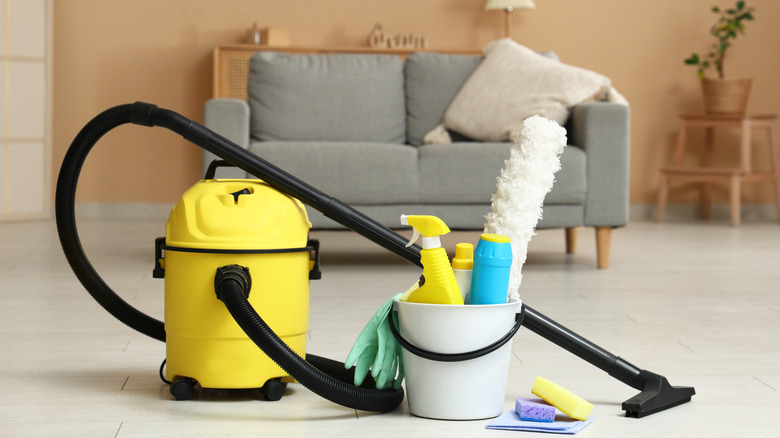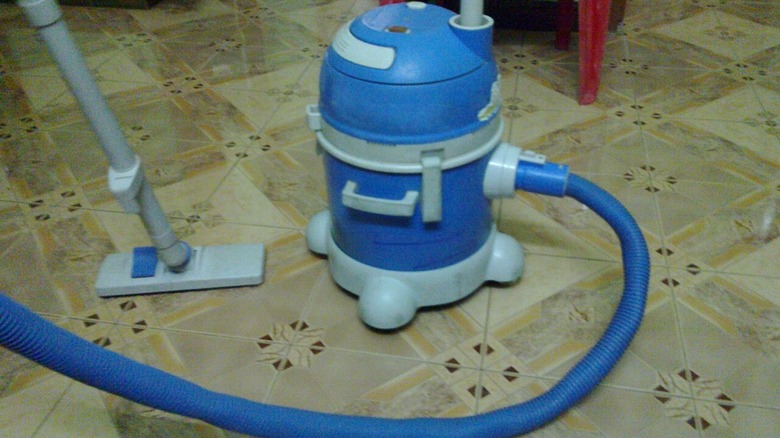This DIY Vacuum Magnet Stops You From Sucking Up Something You Shouldn't
Robot vacuum cleaners have become a lot more sophisticated at detecting and avoiding obstacles, not to mention following preset paths and deviating from them where necessary. It's a greater challenge, however, to determine which pieces of detritus are supposed to be vacuumed up and which aren't, which is a potential thing to bear in mind before buying a robot vacuum. Fortunately, we can rely on the Internet to devise ingenious DIY ways around this problem. In this case, it's a homemade attachment for a vacuum cleaner that is able to catch any magnetic objects. Tip_centric on Instagram has a convenient way of managing this issue, showing you how to make a simple and effective magnetic attachment that will catch intruders:
To create the DIY vacuum magnet as demonstrated above, simply glue a series of small magnets to an appropriate length of wood, before drilling two holes in the top to attach a hook (or shape a length of wire in order to form one) that will secure the magnet inside the vacuum hose. If, for instance, you do a lot of woodwork at home and have a workshop to clear of shavings, you might not see any iron interlopers (or the like) until it's too late. At the end of the vacuuming session, you can easily detach it and remove the metal pieces that have clung to it. Of course, there are certain things to be wary of. Let's take a look at some reasons why you might want to use such a home-made vacuum attachment, as well as some alternatives to doing so for those who may not be DIY-inclined.
Metal objects can cause damage to vacuum cleaners
Your average vacuum cleaner, of course, is going to be up to the task of tackling most household dust, dirt, and small pieces of food. These are the bread and butter of a vacuum, broadly speaking, and shouldn't pose a danger. A critical thing to remember about vacuum cleaners is that despite being common household appliances, they're quite sophisticated devices. As such, they have a wide array of delicate internal components, which could be easily damaged by objects that the system isn't designed to accommodate. There are certain types of objects in your home that you should always try to avoid vacuuming, and small pieces of metal are some of the most dangerous. These can harm the crucial and delicate internal workings of a vacuum cleaner, such as the hose itself, and potentially even cause it to catch fire.
Of course, most coins won't be captured by a magnetic attachment such as this one. In the United States in particular, as Coin World puts it, "The only domestic coins that should stick to a magnet are the 1943 Lincoln zinc-coated steel cents." Nonetheless, all kinds of magnet-loving metals could cause havoc to the inside of a vacuum cleaner. If you're hoovering your garage, for instance, and particularly if it's a busy one, you'd be hard-pressed to pick up every little stray screw or bolt before vacuuming. Depending on the materials you're working with, then, this could be just what you need. Another thing to remember is that, as the attachment is quite large, it can prevent passage of larger objects (vacuumed up intentionally). Naturally, a lot is also going to depend on the type of vacuum cleaner you're using, because some models are far better suited to more heavy-duty jobs.
The kinds of vacuum cleaners that would be best served by this DIY project
The danger with metallic objects is primarily that they could damage the workings of the machine, as we've seen. Catching them is also critical, though, when we simply don't want something to get lost in the vacuum bag. This excellent project provides a simple clip-on means of protecting your vacuum and saving time, and those who work with metal frequently will surely appreciate the sentiment. You may already be in the habit of retrieving items from your vacuum bag or machine's other depths using a magnet, but this isn't always practical and also runs the risk of harming the mechanisms. This project, in that sort of case, could be just the ticket for you.
Note, though, that vacuums are all very different. They're available in different sizes and strengths for different tasks. A smaller and more portable model for light carpet de-dusting, for example, definitely may not survive an encounter with a harsh piece of metal, while a larger and more robust model designed for heavier-duty jobs, such as a shop vac, may well not even flinch at such a task. As long as enough space remains inside the tube after doing so, you can work away, but do be careful to customize your new clip to the size of the vacuum you have. "This should come as standard" is the caption that tip_centric has added to the video. While the value could be considered a little niche for some users, it's something that could very well be invaluable. Do you spend a lot of time trying to retrieve your DIY supplies like washers that have accidentally been sucked up? Consider making one of these.


